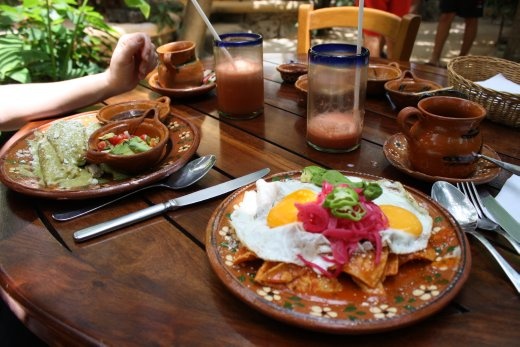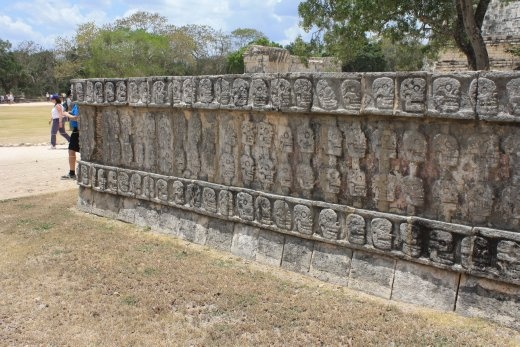The last couple of weeks have been spent on the Yucatan Peninsula and Chiapas regions of southern Mexico. These areas are famous for beaches (especially Cancun), Mayan ruins, cave diving, being hot and old Spanish settlements. Our travels took us from Playa del Carmen to Tulum, Merida, Palenque and finally to San Cristobal de las Casas, where we are currently staying.
Our first few days were beach bumming in Playa. Its fair to say that essentially 12 months of winter and 6 months in Whistler left us the whitest people on the beach. Its been so long since we saw proper sun that Bron had forgotten how to put on sunscreen and got herself pretty badly burnt in a couple of places she missed with sunscreen. It was beautiful getting some sun and swimming in the warm Carribean water, it felt like the cold of the last 6 months was being soaked out of our bodies. Playa del Carmen itself is a weird town - its really taken off for tourism in the last 10 or 12 years, and there are places being built everywhere. The avenue running along the beach is pretty well developed and is covered in 4 story hotels (as opposed to 12 storey hotels in Cancun). The beach is covered in tourists and touts, but as soon as you walk in a couple of streets, you're back into a basic town. The food was nice, and it was an easy place to switch into Mexican mode, but a few nights was heaps to spend there.

Mexican breakfast, complete with habaneros, juice, and salsas both hot and mild
Tulum is a less developed beach-bum town, with some small ruins and an excellent cenote nearby. The excellent hostel we were staying with provided us with bikes so we could get around. Our first day there we hit up Gran Cenote. Cenotes are sinkholes - underground caves with swimming holes, and the Yucatan Peninsula has more of them than anywhere else in the world, with a connected underground river network spanning over 150kms. The cenote was beautiful - a big water hole surrounding an island, with a big cave area complete with stalectites that can be swum under and into another cenote. The water was cool, not cold, and super refreshing following the ride in the heat. We had some snorkel gear from the hostel, and it was fun swimming in under the stalectites and popping up into holes.

We also visited the Tulum ruins, but these will be covered later. The beach was fairly nice, although windy. We got up early one morning to check out the sunrise - definitely worthwhile doing if you ever visit the area.
Between Tulum and Merida is Chichen Itza, one of the most famous archaelogical sites in the area. Again, discussed later.
Next stop was Merida, the inland capital of the Yucatan. Merida is a beautiful old city, with pretty old buildings, some of which were constructed from old Mayan ruins. The night we arrived to Merida, there was the big weekend markets in the centre square, just outside our hostel, with dancing contests, markets, and loads of food stalls, including one selling some tasty churros. The buildings were nicely lit up, and we had a great time wandering around for a couple of hours, soaking in the energy. Both of us agreed that Merida had more energy than New York City. Cool place.

Whilst at Merida, we visited the Cenotes de Cozuma, a trio of cenotes accessed from a town about 80km from Merida. We caught a collectivo to Cozuma. To visit the cenotes, you get a cart which is pulled along a narrow rail track by a horse. The first cenote was quite an open sinkhole, accessed through a large staircase. It was nice enough, but quite busy and despite having a nice big cave, not overly imposing. The second cenote was a tighter entrance, with narrow stairs leading into a circular pool, with light filtering through a reasonable sized hole in the ceiling, and tree-roots hanging down which can be climbed up to jump back in. The third cenote was most imposing, with a ladder leading down though a small hole into the cavern. The only light source was a small hole in the ceiling, meaning most of the water was dark, and just the centre of the pool was lit. Incredible. Definitely a must-do sidetrip.
Unfortunately, Bron got pretty sick in Merida with some food poisoning. With some anti-biotics, she was able to get through ok and thought she'd fought it off, and battled through the trip to the cenotes and to a couple of the ruins. By the morning we left to San Cristobal, she was really sick, and that is a rough bus trip - 6 hours of winding up a mountain on poor quality roads covered in speed bumps every 100m or so for no apparent reason. A good time she did not have... The anti-biotics are kicking in again, so hopefully she'll be back on her feet again in the next day or so.
So anyways, to the ruins. So far we have visited four sets of Mayan ruins (Tulum, Chichen Itza, Uxmal and Palenque) - they are all from different time periods and all very different. So, which Mayan Ruin are you?
TULUM
Tulum is a small set of ruins, overlooking the coast. It was originally a trading village, and was the newest of the ruins that we have seen so far. Most of the buildings are pretty basic, although there are some interesting designs of Mayan Gods descending on some of the buildings. The place is populated by a huge number of iguannas, which are pretty awesome. The cliff and beach are are really nice, with a couple of the beach front buildings particularly nice. There is also the interesting Casa del Cenote, which is a building constructed over a cenote. You can see most of the site in an hour or so, before hitting up the beach. Only a little of the site can be explored.

CHICHEN ITZA
Chichen Itza was settled for over 1000 years. It contains probably the most famous Mayan ruin (El Castillo) and is a UNESCO listed heritage site, and recently named one of the 7 New Wonders of the World on a dodgy poll voted by the public run by a company. It receives over 1,000,000 visitors a year, and has a fascinating history of war, sacrifice and mystique. For a long period it was the dominant Mayan city, and from its wealth developed a range of large and impressive temples, aligned according to the stars. Many of the temples form part of the Mayan calendar, with El Castillo generating a serpant illusion each equinox the most famous of these.
The Mayan's at Chichen Itza had a history of sacrifice - in one of the cenotes at the site the remains of over 50 people (mostly young women) were recovered, along with jade jewelery and other valuables, sacrificed to the water god. Most of the friezes at the site contain images of warriors, sacrificed ball players, skulls or jaguars and eagles either holding or eating human hearts. So, they weren't necessarily nice guys.
Along with El Castillo, there are dozens of really interesting temples and other buildings, with lots of well preserved sculptures, columns and friezes. It made for a full day exploring the site, and was fascinating.
Despite the scale and quality of the site, there are a few issues. Firstly, the site is full of hawkers, especially at the entrance and around El Castillo. They will approach you continuously trying to sell you the same overpriced crap the last 15 hawkers have tried unsuccessfully to palm off to you. The most popular souvenir is a kazoo type thing that imitates a jaguar roar. Every kid at the site gets one, so rather than a nice bird-noise, the sounds of the site are dominated by a 'raarrrr' every 3 or 4 seconds, which does nothing for the atmosphere. Finally, after an American woman fell to her death in 2006, the ruins and the chambers are virtually all off-limit for exploration or climbing, which removes some of the intimacy away from the site, especially when combined with the huge number of visitors, especially on Sunday's, when entry is free for Mexican citizens.
That said, the ruins are incredible, and this site is definitely a must-do if in the area.

UXMAL
Uxmal is not as busy at the other ruins we visited, and therein lies its charm. A day trip from Merida, it is easy enough to get to, and happily most of the buildings and temples can be scaled and explored. There are no hawkers at the site, a happy change from Chichen Itza, and most of the time we were there, we could see maybe one or two other visitors. The site has a lot of birds and iguannas, and the songs of the birds and rustling of the lizards in the bush made for a good atmosphere.
The buildings at Uxmal aren't of the scale of Chichen Itza, and the friezes aren't as impressive, but it does have some large temples and impressive buildings of its own. Being able to enter the buildings does provide a nice avenue to escape the heat, pleasant when its 40C with little or no wind. The steps accessing the temples were steep, and at the top offer some impressive views of the excavated ruins, as well as a couple not fully excavated.
The beauty of Uxmal is that it is quiet, and gives a much more personal experience. Its nice to be able to get a little more hands on exploring the site too. A good day trip, probably not un-missable.

PALENQUE
Palenque is a fair bit further south than the other ruins, and is located right in the tropics. This means that the site is hot and very humid, and located amidst jungle, most of which hasn't been disturbed in excavating the ruins, making for an incredible looking site, but also meaning you either want to get to the site very early or very late to avoid the heat.
Of the ruins we have been to, Palenque is the most interactive we have been to. Virtually all of the ruins can be accessed with the exceptions of some chambers where it is pitch black, or where there are valuable archaelogical relics, such as high quality significant friezes or sarcophagus; even then with one or two exceptions the sites can be entered and explored. The Palace, in particular, is incredible, a labyrinth of rooms, courtyards, chambers and access tunnels, with friezes, windows and murals dotted around the place.
Of the sites we went to, this is one of the oldest, first settled around 100BC and peaking around 600-700AD. The buildings are surprisingly complicated, with stairs, hidden tombs and the like all about the site. The site is a large one, and even though it is very busy, the more out of the way sites become quiet. The Temple of the Inscriptions is one of the most important Mayan archaeological sites, but largely inaccessible, because of that.
A really interesting site - my favourite to date, but the humidity and heat can be oppressive, and Palenque town is a hole. Try and find accommodation with air conditioning and/or a pool to recover, or the rest of the stay there can be unpleasant.

BACK TO GENERAL MEXICO
Lots of people seem to think that Mexico is incredibly dangerous, and at the moment perhaps in the north it is. However, from our experience the people here have been incredible, and not once have we felt threatened. There is a steady police and military presence everywhere we've been. There's great food, great sites, nice beaches, good hostels. Mexico is definitely worth a trip.